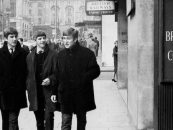Jan. 27, 1984: Michael Jackson Burned in Pepsi Spot
by Best Classic Bands Staff
Michael Jackson, standing behind one of his brothers, at the moment his hair caught on fire while filming a Pepsi commercial (Photo via YouTube)
It was just supposed to be a routine commercial shoot: Michael Jackson, just 25 years old, was the biggest star in the world, his 1982 Thriller album having logged the better part of a year at #1. In the fall of ’83 he and his Jackson Five brothers signed a $5 million endorsement deal with PepsiCo that would include, among other promotions, Michael appearing in commercials pushing the soft drink.
On January 27, 1984, Michael and his brothers were doing just that. It didn’t go well: At the Shrine Auditorium in Los Angeles, in front of an audience of 3,000, assembled to create the concert environment, Michael was dancing to his hit “Billie Jean.” During the sixth take for the commercial, he apparently veered too close to a pyrotechnics display, which had gone off a bit too early. He was set ablaze by the fireworks, suffering second-degree burns to his scalp and losing some of his hair. His jacket also caught on fire.
Jackson’s brothers quickly helped to extinguish the flames and Michael seen by his fans with his scalp glowing and smoke billowing from his head. Following the incident, Jackson—his head bandaged and seen smiling even as he was in pain—was rushed to Cedars-Sinai Medical Center. There he was treated and declared out of mortal danger, but the singer was then transferred by ambulance to Brotman Memorial Hospital Burn Center in Culver City, California. It was later determined that the pomade Jackson used in his hair was the culprit, catching fire when he neared the fireworks. Still, regardless of the cause, Jackson underwent treatment to hide the scars and had his third nose job shortly thereafter.
It was later reported that the pain Jackson suffered on his scalp from the burns was prolonged and led to his prescription pill addiction. His hair never grew back properly either, which reportedly led to Jackson wearing wigs.
Related: “Thriller” co-writer Rod Temperton dies
There would, of course, also be legal action. Pepsi settled out of court with Jackson, and the performer donated the $1.5 million payment to the Brotman Medical Center; its Michael Jackson Burn Center was subsequently named in his honor.
No hard feelings, though: Jackson later signed another deal with Pepsi, this time for $10 million.
Advertising executive Phil Dusenberry, one of the engineers of the Pepsi-Jackson endorsement deals, later titled his memoir Then We Set His Hair on Fire: Insights and Accidents from a Hall of Fame Career in Advertising.
Watch an Us Weekly video that shows the moment Jackson was set on fire (warning: some may find this graphic footage disturbing)
Watch the extended version of a spectacular – for the time – Bob Giraldi-directed Pepsi spot featuring the Jacksons
Related: Jackson’s wife of two years, Lisa Marie Presley, died in 2023







3 Comments so far
Jump into a conversationIt is interesting that MJ was having a great solo career and decided to include his brothers in this lucrative commercial deal.
It is clear that MJ had as many hangups as the next pop star.
So sad that it lead to his serious injury which seems to have kicked off his lifelong addiction to narcotics at a young age.
So many in show business are susceptible to addiction. Looks like this event sped up the process for him.
Many people become dependent on Pain killer after an injury. What he really became addicted to after this incident was Surgery. The prescription drug addiction came from his back injury years later and trouble sleeping after he waw targeted with those False Allegations.
In an interview, Micheal stated that his immediate family was always bothering him for more money all the time. Wanting to maintain lavish lifestyles that his income could afford, but not theirs. Small wonder he included his siblings in that commercial deal.